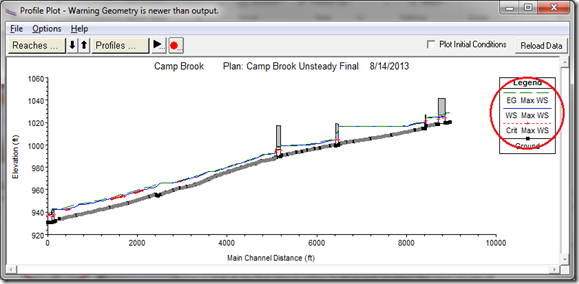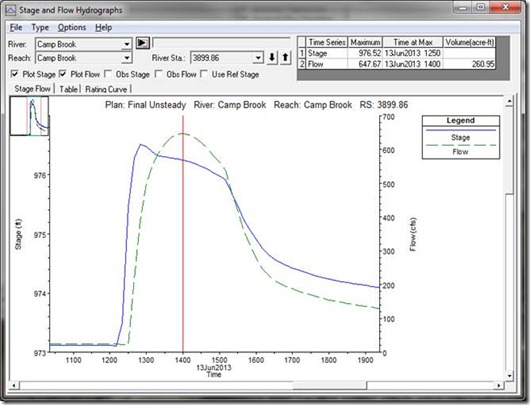
Multiple Opening Analysis
Did you know that if you have a bridge opening and one or more culverts at a single river crossing a Multiple Opening Analysis is required?
I’m a big proponent of checking flow consistency in your results. Anyone who has taken a RAS class from me has heard me go on about Standard Table 2 and the benefits of maintaining a consistent distribution of flow not only between sub sections (left overbank, main channel, right overbank) in a cross section, but from cross section to cross section. Any significant change in flow, or flow distribution should be questioned and explained. Generally there is a problem with ineffective flow definitions, Manning’s n values, bank station placement, or your model is simply unstable (for an unsteady flow model).

After running an unsteady flow model, and you open up the profile output table (also called summary output table), the first profile that pops up is the Max WS profile. Now, you have to be careful when checking flow distribution with the Max WS profile. Although it shows up in the plot and tables along with all of the other profiles, the Max WS profile is not a real profile. It never happened. It is actually a compilation of all of the highest water surface elevations that happened during the simulation for each cross section-regardless of time. A “Greatest Hits” of water surface elevations, if you will. This is exactly what you would plot when producing a maximum inundation map.

For many models, the Max WS profile will do just fine in identifying flow distribution problems with an important exception – reaches that have significant lateral inflows whose peak flows do not line up temporally with the main channel peak flow. If that lateral inflow sets up a backwater in the main channel, prior to the arrival of the flood in the main channel, it could actually produce a higher peak water surface elevation than the elevation that corresponds to the peak of the main channel flood.
Here’s an example from a question I recently got from a former attendee of one of my RAS courses. Warning, this gets a bit detailed and specific-make sure you’re wide awake before reading on…
Question: “I’m currently working on an unsteady model where I have my initial flow hydrograph and then two lateral inflow hydrograph’s further downstream. My question is that at my first lateral inflow hydrograph location the next couple of cross-sections upstream of the inflow point have greatly reduced peak flows. For instance, the peak flow of the hydrograph entering the upstream end of the reach is around 646 cfs and at the cross-sections just upstream of the lateral inflow that number is reduced down to around 387 cfs. There is not a drastic change in cross-section shape or stream slope in the area of the lateral inflow. Have you run across this type of thing before? Is this realistic or is something in the model not quite right? Any thoughts would be greatly appreciated.”
Response: What looks like an inconsistency, really is not. In fact your results look great. When checking flow consistency, be careful doing this with the MaxWS profile in the summary output table. This is where you saw the drop from 646.61 cfs to 387.53 cfs from RS 3936.90 to RS 3899.86. The problem with checking flow consistency on the MaxWS profile is that the maximum water surface does not necessarily correspond to the maximum flow, especially if you are in a backwater area like below. This backwater is set up by the lateral inflow entered just downstream at RS 3726.34 and happens prior to the arrival of the peak flow in the main channel. A very common occurrence when modeling a flood in large systems with multiple tributaries. The peak of the lateral inflow at 3726 happens at 1250 hrs on the 13th. This sets up a backwater that produces the max ws elevation of 976.52 ft for RS 3899.86. However, the flow at RS 3899.86 at this moment is only 389.13 cfs.
The peak flow in the main channel has not arrived yet. The peak flow in the main channel at RS 3899.86 happens after the lateral inflow peak by about 1 hour and 10 minutes. At 1400 hrs, the backwater effect from the lateral inflow is almost completely gone at RS 3899.86 and the peak flow is 647.59 cfs with a corresponding ws elevation of 976.25 ft. 
 As a result, what you see in the max ws profile is not the max flow at RS 3899.86, but the flow that is happening during the max ws elevation. You can see all of this by checking around the stage and flow hydrographs. If you see inconsistencies like this for the max ws profile, you can verify your results are still good by scanning through each individual real profile in the summary output table (cumbersome), or go to the dss file and open up the max flow profile like so: This gives you a plot like this: Notice that the max flow at 3899.86 is indeed in the 650-ish range, which is where it should be. The big changes in max flow are where you have your lateral inflow hydrographs.
As a result, what you see in the max ws profile is not the max flow at RS 3899.86, but the flow that is happening during the max ws elevation. You can see all of this by checking around the stage and flow hydrographs. If you see inconsistencies like this for the max ws profile, you can verify your results are still good by scanning through each individual real profile in the summary output table (cumbersome), or go to the dss file and open up the max flow profile like so: This gives you a plot like this: Notice that the max flow at 3899.86 is indeed in the 650-ish range, which is where it should be. The big changes in max flow are where you have your lateral inflow hydrographs. 
Comments
Add Your Comment